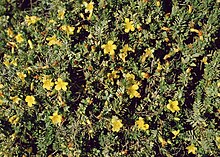| Hypericum aegypticum | |
|---|---|

| |
| Scientific classification | |
| Kingdom: | Plantae |
| Clade: | Tracheophytes |
| Clade: | Angiosperms |
| Clade: | Eudicots |
| Clade: | Rosids |
| Order: | Malpighiales |
| Family: | Hypericaceae |
| Genus: | Hypericum |
| Section: | Hypericum sect. Adenotrias |
| Species: | H. aegypticum
|
| Binomial name | |
| Hypericum aegypticum | |
| Subspecies | |
| Synonyms[1][2] | |
Hypericum aegypticum is a species of flowering plant of the St. John's wort family (Hypericaceae) which is native to the Eastern Mediterranean. It was described by Carl Linnaeus in the second volume of his Species Plantarum in 1753, who named it after Egypt despite it not being distributed there. The plant is commonly known as shrubby St. John's wort or Egyptian St. John's wort in English. Like other members of section Adenotrias, it is found among limestone rocks in coastal areas. While it has been evaluated as threatened on the island of Malta, the species has no legal protections.
The species is a shrub or shrublet that grows up to 2 meters (6.5 feet) tall with many branches, each having a single small flower with five yellow petals and many stamens. Its leaves lack hairs, and have densely patterned glands and large primary veins. The species is notable for its heterostyly, a trait which within the Hypericum genus is unique to section Adenotrias, and exhibits one of two heterostylous flower types called "pins" and "thrums". It has three subspecies, which vary in their distribution and phytochemical makeup.